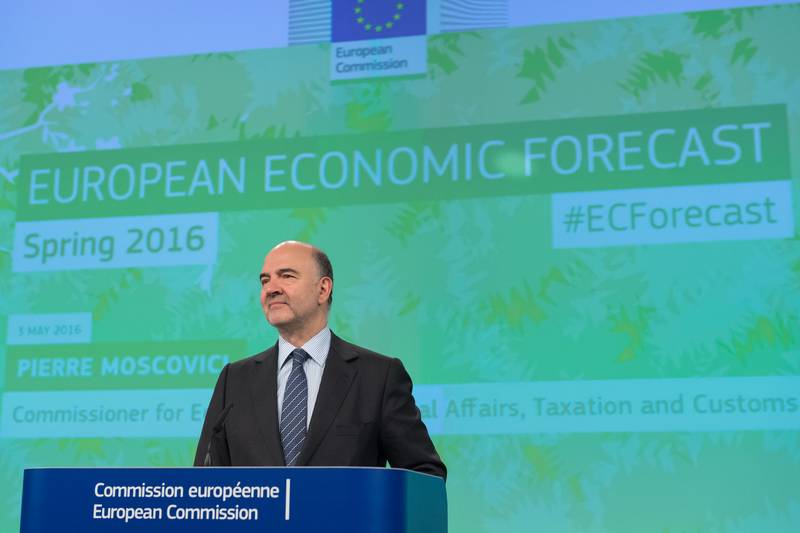Spring Economic Forecast: Going out of Austerity Back To Keynesianism
Adelina Marini, May 7, 2016
 This week, the European Commission revised down its forecast for the EU’s economic growth because of the continuing global instability, but also because of the internal European instability. The EC expects the effect on growth of the low oil prices and the devaluation of the euro to wane, leaving consumption as the sole engine of economic growth. At the presentation of the forecast, economic Commissioner Pierre Moscovici (France, Socialists and Democrats) commended the European Central Bank’s monetary policy, stating that it does work and produces results. He also urged for a cautious loosening of belts and winked at Keynesianism. However, Mr Moscovici stated that public enemy number one of investment continues to be the huge public debt, which continues to throttle growth in several euro area member states.
This week, the European Commission revised down its forecast for the EU’s economic growth because of the continuing global instability, but also because of the internal European instability. The EC expects the effect on growth of the low oil prices and the devaluation of the euro to wane, leaving consumption as the sole engine of economic growth. At the presentation of the forecast, economic Commissioner Pierre Moscovici (France, Socialists and Democrats) commended the European Central Bank’s monetary policy, stating that it does work and produces results. He also urged for a cautious loosening of belts and winked at Keynesianism. However, Mr Moscovici stated that public enemy number one of investment continues to be the huge public debt, which continues to throttle growth in several euro area member states.
The EC’s expectations are for GDP growth inside the currency club to be a little lower than what was in the winter forecast – 1.6% and up to 1.8% in the EU. When looked in detail, country-by-country, however, the spring economic forecast shows an entirely different picture. Although expectations for the economic performance of the European economy were lowered, in fact, the economic forecast for a third of the Union was revised up. The performance of the economies of Bulgaria, Ireland, Cyprus (not completely), Hungary, Malta, Poland, Finland and Sweden (also not completely) surpasses the winter expectations of the EC. In winter, the EC expected Bulgarian economy to grow by 1.5% this year and 2.0% next year, but the spring forecast is considerably higher – 2.0% as early as this year and 2.4% next year. Regardless, The EC points out that the Bulgarian economy is facing moderate growth.
The forecast shows that Bulgarian economy is heavily dependent on EU funds absorption. They are also the reason for the slow-down of growth compared to last year, when the real GDP grew by 3%. Commissioner Moscovici expressed hope that the slow-down in EU funds absorption is just temporary. Ireland continues to be uncatchable economic champion. In winter, the Commission expected Irish economy to grow by 4.5% in 2016 and 3.5% in 2017, but in spring it hiked-up its expectations to 4.9% for this year and 3.7% for next. This growth dynamics leads to an improvement of the country’s fiscal position. Regardless, the EC warns that levels of public and private debt remain too high and urges for caution because of external insecurity.
At least for now, domestic insecurity is expected to be terminated by the formation of a new government, once again headed by current PM Enda Kenny, after heavy negotiations two months after the parliamentary elections in Ireland. The public debt of Ireland is expected to be 89.1% this year and drop next year to 86.6%. Cyprus, which recently emerged from its bailout programme, also has its forecast revised up. Expectations for Cypriot economic growth are 1.7% for this year and 2.0% for next. The change upward is just for this year, because back in winter the EC expected the economy of Cyprus to grow by 1.5%. The forecast of 2.0% for next year remains unchanged since winter. Cyprus is also possibly the only EU member state with the lowest budget deficit of -0.4% this year. For next year the EC expects a balanced budget.
Cyprus is ranking among the states with big public debt. It is expected to reach 108.9% this year and start to drop next year to 105.4%. Hungary is another member state that the EC has increased its economic expectations for. From 2.1% for this year and 2.5% for next, Hungary’s economic growth is expected to reach 2.5% in 2016 and 2.8% next year. The EC is extremely neutral in its forecast for Hungary, unlike the International Monetary Fund, which warned that increased debt levels and financial needs make the economy susceptible to shocks. The EC expects Hungarian public debt to be 74.3% this year and 73% next. The more serious warning of the IMF, however, is in a different direction – the overgrowing role of the government in the economy and the transfer of risks towards the public sector.
Malta’s economy is also performing better than expected. In winter, the expected growth was 3.9% for this year and now the expectations are for 4.1%. For next year the increase is from 3.4% to 3.5%. Polish economy, too, exceeds winter forecasts. Back then, the EC bet on 3.5% for this year and next, but revised it on Tuesday to 3.7% and 3.6% respectively. Finland is walking out of recession much more sure-footedly than what was expected in winter (0.5% for 2016 and 0.9% for 2017) – 0.7% for this year and next. The Finnish forecast is one of the few where the EC is preparing the ground for the country-specific recommendations, which will be presented at the end of the month. There are warnings that fiscal consolidation and weak household income growth are tripping consumption, but investments are coming back. The problem, however, is that the ageing population is expected to increase pension expenditure.
Finland is the only state for which the EC sees a rather negative effect from asylum-seekers. In the entire spring forecast, the problem is mentioned for very few member states, but in most cases the stress is on the positive effect from them. In the case of Finland, the EC says that costs for those who had arrived in 2015 will increase this year. In neighbouring Sweden, the situation is considerably better. There, economic growth is expected to increase this year by 3.4% instead of 3.2%. The forecast remains the same for next year as was in winter – 2.9%. Sweden is one of the countries, for which the refugees effect is mentioned in a positive manner. It is pointed out that unemployment is expected to gradually decline, despite the high influx of asylum seekers last year. The reason is their entrance in the labour market. Swedish unemployment is expected to be 6.8% this year and 6.3% next.
Expectations for France and Romania remain the same as in winter. French economy will grow by 1.3% this year and by 1.7% in 2017. The Commission’s assessment is that the French economy is moving slowly towards self -sustained recovery. The Romanian case is the most worrying to the EC. Fiscal expansion is growing and so are finance risks. GDP is expected to grow by 4.2% this year and 3.7% next year. The problem, however, is that budget deficit is also expected to grow to -2.8% this year and -3.4% next year. The reasons being the tax cuts and increase in spending. According to the EC, risks for the Romanian economy are serious because of the law for debt cancellation which was voted in by Parliament on April 13. The EC believes this law will have “a substantial negative impact on investor confidence and credit outlook”. All of this in an uncertain external environment.
The IMF also has serious concerns about this law and other legislative initiatives as well. In its assessment at the end of its mission in Romania in March, the IMF points out that macroeconomic policy has weakened considerably and places the hard won benefits at risk. This year’s budget “inappropriately” stimulates when consumption is already high enough. Legislative measures in the financial sector are threatening private property rights, undermine investor sentiment and credit availability to households and businesses. The Fund’s mission recommended in March more caution with special accent on the unusual opening of the state purse because of the upcoming parliamentary elections.
In all other member states the EC sees less potential than in the winter. One of the states which has concerns in its forecast is Slovenia. This is the country that managed to avoid going into bailout regime with a programme dictated from the outside, but the EC believes there are serious risks to public finances still present. Uncertainty stems from the costs, linked to migration, but a considerable problem are also the non-performing loans. According to data from the European Parliament’s economic division from September of last year, the share of non-performing loans in Slovenia was 15.2%. This is, however, lower than in neighbouring Hungary (16.0%) or Italy (16.9%). Portugal, which went through a bailout regime, has a bad loans percentage of 18.5%. The highest rate is in Cyprus (43.5%), followed by Ireland (20.6%).
Slovenia’s budget deficit for this year is expected to be -2.4% this year and -2.1% next year. Public debt will be 80.2% this year and 78% next. The IMF is far more sceptical towards Slovenia. The Fund’s March mission came out with several worrying conclusions. The first one is that investments are hobbled because of excessive debt, especially in small and medium enterprises. The business environment is also quite overloaded, productivity is low. The IMF feels that the government in Ljubljana could be far more ambitious regarding reforms. This would aid the state in growing much faster than currently (1.7% in 2016, lowered from 1.8% for this year). For next year, the EC expects  Slovenian economy to grow by 2.3% with the IMF thinking this could be accelerated if privatisation continued.
Slovenian economy to grow by 2.3% with the IMF thinking this could be accelerated if privatisation continued.
The other problematic country to the EC is Portugal, which was expected to be a successful example for a well completed bailout programme, but political uncertainty in the country undermines the already not too convincing successes, compared to Ireland, for example. The EC sees slow recovery and very serious risks. It doubts the feasibility of the fiscal consolidation agreement in 2016 and 2017. The GDP growth projections for this year and next are 1.5% and 1.7%. Debt, however, remains quite substantial – it is expected to be 126% this year and 124.5% next year. At the same time, budget deficit is forecasted to be -2.7% this year and -2.3% in 2017.
France, Spain and Greece will be the only member states whose budget deficit will exceed the 3-percent barrier. French budget deficit is expected to be -3.4%, Spanish -3.9%, and the Greek one -3.1%. The last one is something more than a forecast. This is the target that European institutions insist on and the Greek government is attempting to get a discount on. A solution to this problem will be sought at the emergency meeting of the Eurogroup on the Day of Europe (May 9). Commissioner Moscovici outlined five main lessons in the spring economic forecast. The first one is that European growth will remain moderate during this year and next. The second one is that economic growth continues despite the negative external circumstances. The third one is that European growth is due mainly to domestic spending and the fourth one – that unemployment drops, although slower than desired. The last lesson is that public deficit and debt are dropping.
The French commissioner specially stressed on the March measures of the ECB, which, in his words, led to an improved access to loans and lower costs of financing to businesses and households. In general, the effect of refugees is positive, especially in Germany and Austria. About the latter, the EC believes that the ongoing inflow of refugees supports private and public consumption as well as the supply of labour. This is a hidden message to Austria, which did an 180-degree turn in its policy towards refugees.
Countries, whose economies will grow faster than 3% this year are Ireland (4.9%), Luxembourg (3.3%), Malta (4.1%), Poland (3.7%), Romania (4.2%), Slovakia (3.2%), Sweden (3.4%). Growth below 1% will have Greece (-0.3%) and Finland (0.7%). All the rest are in the range of 1.1% to 2.9%. Pierre Moscovici recommends a little more expansionist fiscal policy, but urged that more attention is paid to the quality of public investments. The European Commission bets heavily that Juncker’s investment plan will contribute substantially to economic growth in the EU. He answered a journalist’s question that he always felt a Keynesian, but this is not exactly what is needed right now.
More public expenses are necessary, but the situation is not the same as in the 30’s of last century. “But I think that Keynesianism remains of very high importance when we think about economy”, he said and hurried adding that, once again, he fully agrees with ECB boss Mario Draghi, according to whom the key is in structural reforms. The states with highest public debt this year will be Greece (182.2%), Italy (132.7%), and Portugal (126%). The lowest debt continues to be Estonia (9.6%), followed by Luxembourg (22.5%), and Bulgaria (28.1%). The Greek case deserves attention, because in winter it was expected that debt will be 185% of GDP this year. The question is whether the IMF will trust the EC’s projections.
How exactly will the balance between Keynesianism and austerity policy be achieved remains just as difficult a question as before, moreover the forecast shows several controversies, like for Croatia for example. It is clearly stated about it that budget deficit was lowered considerably and is currently under control due to the cutting of public investment. “The pace of the recovery decelerated in the last quarter of 2015 as the positive impact of a record tourism season faded away and public investment contracted more than expected”, says the forecast about Croatia. The other example is Italy, which is in a process of deep economic and political reforms, but has huge debt. Rome demands more flexibility in implementing fiscal rules. Pierre Moscovici said that a solution to this problem is looked for, but within the rules.
Translated by Stanimir Stoev
 Klaus Regling | © Council of the EU
Klaus Regling | © Council of the EU Mario Centeno | © Council of the EU
Mario Centeno | © Council of the EU Mario Centeno | © Council of the EU
Mario Centeno | © Council of the EU